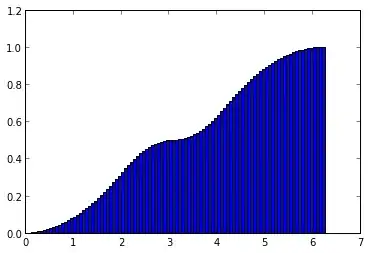Three points $A$, $B$, $C$ are chosen randomly on a circle. Let us consider angles $\alpha$, $\beta$, $\gamma \in [0, 2\pi)$ formed by consecutive pairs of points. Angles are reordered from the smallest to the largest: $\alpha^* \le \beta^* \le \gamma^*$. For given number $x \in \mathbb{R}$ I need to find the probability $P(\beta^* \le x)$.
There are some questions here (this and this) considering same three-point-on-a-circle problems but I don't know what to do with the reordering step. I can start from point $A$ and now three point configuration can be considered as a uniformly distributed point in $[0,2\pi)$ square ($B$ is one axis and $C$ is on another). But now I need to somehow apply the reordering and this is where I stuck.
I've run simple simulation and plotted CDF. Got something like this
Still no ideas though.
EDIT: Simulation code (in Python) for single experiment:
def experiment():
x1 = 2*math.pi*random.random()
x2 = 2*math.pi*random.random()
x3 = 2*math.pi*random.random()
angles = [x1 - x2, x2 - x3, x3 - x1]
for i in range(len(angles)):
if angles[i] < 0:
angles[i] += 2*math.pi
angles.sort()
return angles[1]
matplotlib. But I just used it from insidepylab(ipython notebook --pylab=inlinefrom console window) – Boris Dec 04 '13 at 04:04